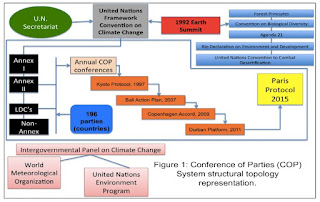This is
going to be one of my last posts for the next time. It does not mean that I
will stop writing, but the main purpose of this blog was a lecture at my
university, which going to end soon.
To
conclude, I will discuss the results of the COP21. The majority, in particular
the press and the politicians are saying that the conference was a success.
They achieved scenario 1 (see my last post, The chance of COP21) a commitment
to stop climate warming below 2 degrees Celsius and even try to reach the 1,5
mark. Moreover, to peak greenhouse gas emissions as soon as possible and to
provide 100$ billion a year to a climate change fond for the developing
countries. (BBC NEWS 2015)
A victory
or a turning point in climate change, as many politicians call it. But if you
look closer to the agreement, you will see that it is more like vague
guidelines. Therefore, a view people, like Professor James Hansen, call this
agreement a ‘fraud’ with ‘no actions, just promises’ (Independent 2015).
Moreover,
yesterday I was at a conference (Socialism, Capitalismand the Alternatives: Lessons from Russia and Eastern Europe), where a speaker (Naomi Klein), who
attended the COP21, gave her opinion. She stressed the same by giving some examples
like ‘to pursue efforts’ or the goal to get a neutral greenhouse gas emission
balance ‘starting at the second half of this century’. A very imprecise
statement, somewhere in the future we are going to try to change something.
Which could mean nothing as well.
In
addition, the neutral greenhouse gas emissions will open the door for
Geoengineering. A state is allowed to do business as usual, to pollute the air,
if it filters the same amount of greenhouse gases from the air, by whatever
means. At my opinion, a concrete invitation to do Geoengineering.
Otherwise,
the COP21 had and still have created an increased global attention to the issue
of climate change, which is good. In addition, the COP21 produced a partly
legally binding agreement to which the different parties should adhere. I think
the enormous public attention will help to force the governments to compliance.









